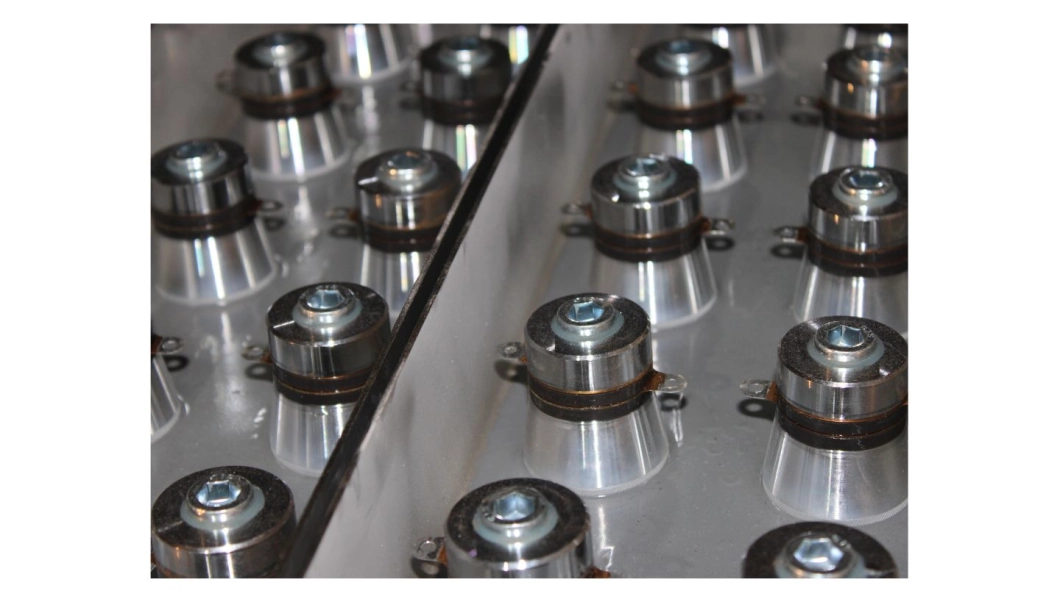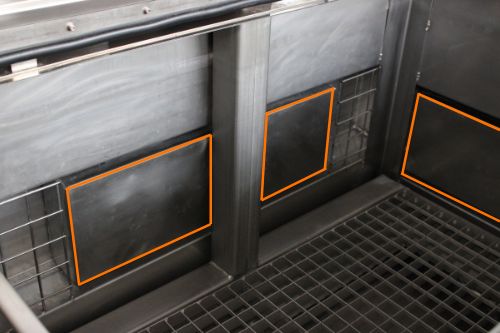Thu, 10 Apr 2025 11:31:30 +0200

At DCM Ultrasonic, we want to clearly and professionally explain how an ultrasonic transmitter works, its key components, its physical principle, practical applications, and the factors to consider when selecting one for your system.
The emitter is part of an ultrasonic transducer, which can be both an emitter and a receiver (or both). In the case of an active emission system, the emitter is responsible for generating the waves that interact with the environment or other materials.
When an alternating signal is applied to a piezoelectric crystal, it vibrates at the same frequency as the electrical signal. If this frequency is within the ultrasonic range, the crystal vibrates rapidly, generating a mechanical wave (sound) that propagates into the surrounding medium.
This process can be summarized in three steps:
DISCOVER OUR HIGHEST-QUALITY ULTRASONIC TRANSMITTERS

An ultrasonic emitter can have a simple or complex structure depending on its application, but generally includes:
1. Air Ultrasonic Transmitters
These are used in proximity sensors, distance measurement, anti-collision systems, or non-contact level detectors. They are optimized to transmit waves through air, generally with frequencies between 20 kHz and 80 kHz.
2. Liquid Ultrasonic Transmitters
Designed to transmit efficiently in liquids such as water, oils, or detergent solutions. They are typical in ultrasonic cleaning systems, flow measurement, level detection, etc.
3. Ultrasonic Transmitters for Solids
In applications such as non-destructive testing (NDT) or industrial inspection, these transmitters transmit waves through solid materials to detect cracks, fissures, or changes in density.
At DCM Ultrasonic, we specialize in the manufacture of ultrasonic generators and transmitters for ultrasonic cleaning.
Ultrasonic transmitters are used in a wide variety of sectors:
✅ Ultrasonic cleaning
The transmitters generate cavitation in liquids, allowing for deep cleaning of metallic, electronic, medical, or mechanical components without damaging the parts.
✅ Detection and Measurement
Used in sensors to measure liquid levels, proximity, flow, or even material thickness. They are also used in ultrasonic vision systems for robots or autonomous vehicles.
✅ Material Inspection
Ultrasonic inspection detects internal defects in metal parts, pipes, concrete structures, or composite components without the need for disassembly.
✅ Ultrasonic Welding
In the plastics or packaging industries, ultrasonic transmitters allow materials to be fused using localized heat generated by high-frequency vibrations.
✅ Biomedicine
Transmitters are used in medical ultrasound to generate internal images of the human body, as well as in therapeutic applications.
At DCM Ultrasonic, for example, the transmitters we integrate into our cleaning or antifoam solutions are carefully selected to ensure continuous performance, reliability, and maximum energy efficiency.
The ultrasonic transmitter is a key component in a multitude of modern technologies. Its ability to transform electrical energy into high-frequency mechanical vibration makes it a versatile, efficient, and adaptable tool for countless processes. Whether in industrial cleaning, quality control, automation, or medicine, understanding how an ultrasonic transmitter works allows you to optimize processes, improve results, and make informed technical decisions.
Want to learn more about how ultrasonic transmitters can improve your production or maintenance? At DCM Ultrasonic, we are experts in integrating ultrasound-based solutions. Contact us for more information!

News
How an ultrasonic transmitter works in industrial cleaning
10 April de 2025
In the world of modern technology, ultrasound plays a fundamental role in multiple industries: cleaning, medicine, industrial automation, robotics, packaging, process control, and more. The heart of any ultrasonic system is the ultrasonic emitter, a device that converts electrical energy into high-frequency sound waves. But how exactly does an ultrasonic emitter work? What are the physical principles behind it? What types exist, and how are they used in real-life industrial applications?At DCM Ultrasonic, we want to clearly and professionally explain how an ultrasonic transmitter works, its key components, its physical principle, practical applications, and the factors to consider when selecting one for your system.
What is an ultrasonic transmitter?
An ultrasonic emitter is a device capable of generating sound waves at frequencies above the threshold of human hearing, i.e., above 20 kHz. These waves propagate in the form of mechanical vibrations through air, liquids, or solids, and are used in a multitude of industrial and scientific processes.The emitter is part of an ultrasonic transducer, which can be both an emitter and a receiver (or both). In the case of an active emission system, the emitter is responsible for generating the waves that interact with the environment or other materials.
Working Principle: Piezoelectricity
The technological basis of most ultrasonic emitters is the inverse piezoelectric effect. This phenomenon was discovered in the 19th century and refers to the ability of certain materials (such as quartz, tourmaline, or ceramic materials such as lead zirconium titanate – PZT) to change shape when an electrical voltage is applied.When an alternating signal is applied to a piezoelectric crystal, it vibrates at the same frequency as the electrical signal. If this frequency is within the ultrasonic range, the crystal vibrates rapidly, generating a mechanical wave (sound) that propagates into the surrounding medium.
This process can be summarized in three steps:
- Electrical signal generation: A generator or oscillator circuit produces a high-frequency alternating signal (e.g., 40 kHz).
- Conversion into mechanical vibration: The piezoelectric material of the emitter vibrates due to the applied signal.
- Emission of ultrasonic waves: The vibrations are transferred to the medium (air, water, metal, etc.) and propagate as high-frequency sound waves.
DISCOVER OUR HIGHEST-QUALITY ULTRASONIC TRANSMITTERS

Main components of an ultrasonic transmitter
An ultrasonic emitter can have a simple or complex structure depending on its application, but generally includes:
- Piezoelectric element: The active core that converts electrical energy into mechanical vibration.
- Housing or encapsulation: Protects the piezoelectric element from environmental conditions (water, dust, heat) and helps channel the emitted waves.
- Electrodes: Allows for electrical connection to the signal generator.
- Acoustic cone or lens (in some models): Focuses or directs the ultrasonic beam to increase its accuracy.
Types of Ultrasonic Transmitters by Medium
Ultrasonic transmitters vary depending on the medium in which they operate:1. Air Ultrasonic Transmitters
These are used in proximity sensors, distance measurement, anti-collision systems, or non-contact level detectors. They are optimized to transmit waves through air, generally with frequencies between 20 kHz and 80 kHz.
2. Liquid Ultrasonic Transmitters
Designed to transmit efficiently in liquids such as water, oils, or detergent solutions. They are typical in ultrasonic cleaning systems, flow measurement, level detection, etc.
3. Ultrasonic Transmitters for Solids
In applications such as non-destructive testing (NDT) or industrial inspection, these transmitters transmit waves through solid materials to detect cracks, fissures, or changes in density.
At DCM Ultrasonic, we specialize in the manufacture of ultrasonic generators and transmitters for ultrasonic cleaning.
Key Technical Parameters
When choosing or designing an ultrasonic transmitter, consider:- Operating frequency: directly affects resolution and penetration. Lower frequencies result in greater penetration. Higher frequencies result in greater detail.
- Acoustic power: the amount of energy emitted by the transducer. This is essential in applications such as ultrasonic cleaning or welding.
- Emission angle: determines the directivity of the ultrasonic beam.
- Acoustic impedance: compatibility with the transmitting medium and the receiving system.
Industrial applications of ultrasonic transmitters
Ultrasonic transmitters are used in a wide variety of sectors:✅ Ultrasonic cleaning
The transmitters generate cavitation in liquids, allowing for deep cleaning of metallic, electronic, medical, or mechanical components without damaging the parts.
✅ Detection and Measurement
Used in sensors to measure liquid levels, proximity, flow, or even material thickness. They are also used in ultrasonic vision systems for robots or autonomous vehicles.
✅ Material Inspection
Ultrasonic inspection detects internal defects in metal parts, pipes, concrete structures, or composite components without the need for disassembly.
✅ Ultrasonic Welding
In the plastics or packaging industries, ultrasonic transmitters allow materials to be fused using localized heat generated by high-frequency vibrations.
✅ Biomedicine
Transmitters are used in medical ultrasound to generate internal images of the human body, as well as in therapeutic applications.
What distinguishes a good ultrasonic transmitter?
A quality ultrasonic transmitter is distinguished by:- Frequency stability: to avoid resonance changes.
- High electrical-acoustic conversion efficiency.
- Durability under extreme conditions (temperature, humidity, chemicals).
- Good compatibility with electronic control systems.
At DCM Ultrasonic, for example, the transmitters we integrate into our cleaning or antifoam solutions are carefully selected to ensure continuous performance, reliability, and maximum energy efficiency.
The ultrasonic transmitter is a key component in a multitude of modern technologies. Its ability to transform electrical energy into high-frequency mechanical vibration makes it a versatile, efficient, and adaptable tool for countless processes. Whether in industrial cleaning, quality control, automation, or medicine, understanding how an ultrasonic transmitter works allows you to optimize processes, improve results, and make informed technical decisions.
Want to learn more about how ultrasonic transmitters can improve your production or maintenance? At DCM Ultrasonic, we are experts in integrating ultrasound-based solutions. Contact us for more information!
